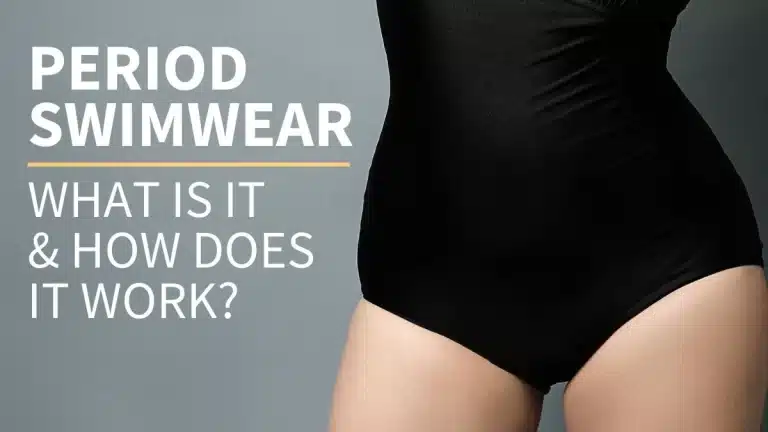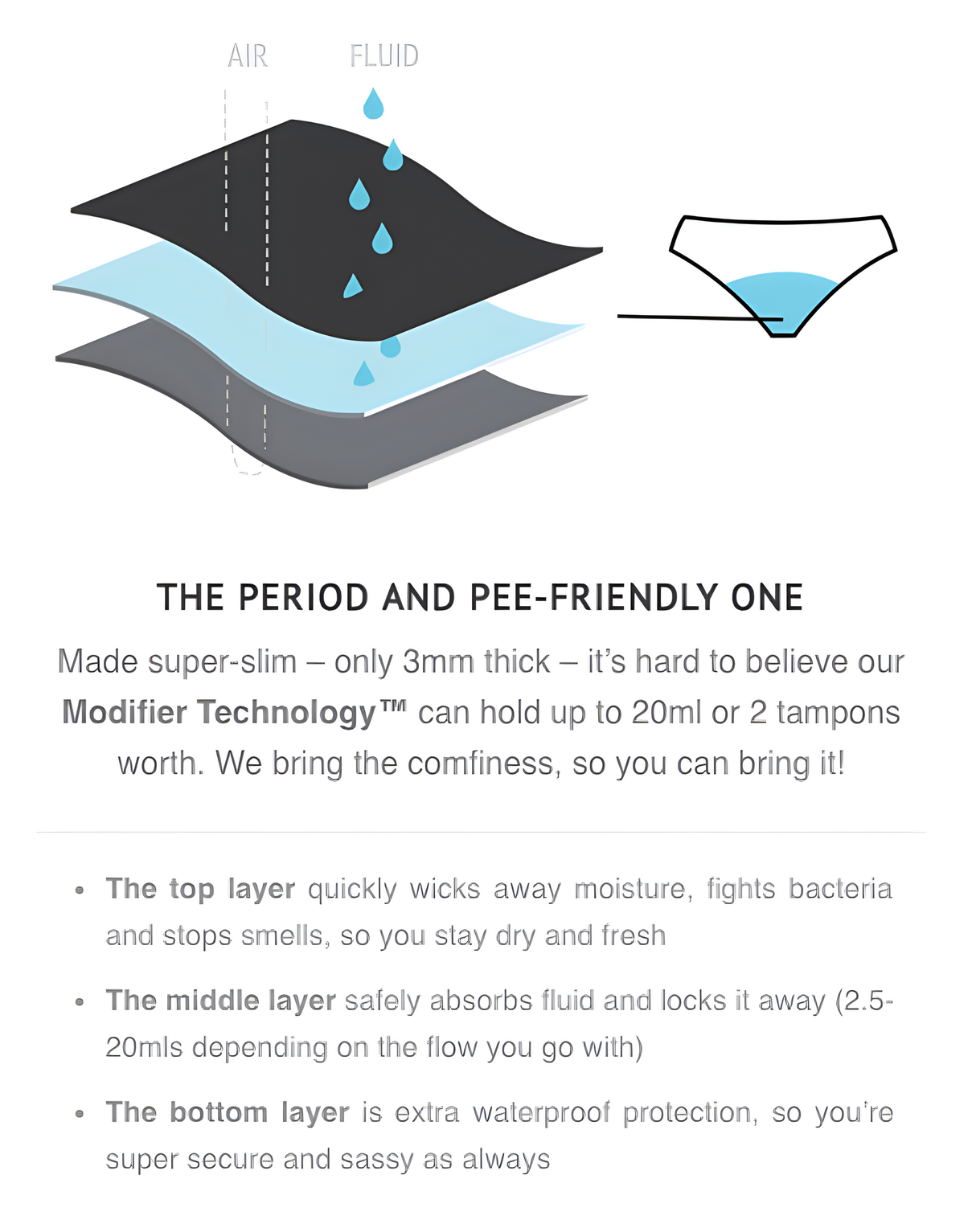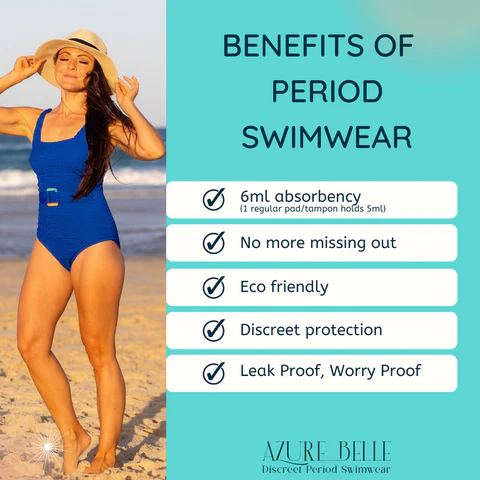Content Menu
● Understanding Period Underwear
>> How Period Underwear Works
>> Benefits of Period Underwear
>> Care Instructions
● Understanding Period Swimwear
>> How Period Swimwear Works
>> Benefits of Period Swimwear
>> Care Instructions
● Key Differences Between Period Underwear and Period Swimwear
● Choosing the Right Product for Your Needs
● Comparative Analysis: Comfort and Fit
>> Comfort Features
● Environmental Impact
● Cultural Perspectives on Menstruation
● User Testimonials
● Conclusion
● Frequently Asked Questions (FAQs)
>> 1. Can I wear period underwear while swimming?
>> 2. How often should I change my period underwear?
>> 3. Can I use period swimwear on heavy flow days?
>> 4. Are there any health risks associated with using these products?
>> 5. How do I care for my period swimwear?
● Citations:
Menstruation can often be a challenging time for individuals, particularly when it comes to managing comfort and hygiene during physical activities like swimming. As a response to these challenges, innovative products such as period underwear and period swimwear have emerged. Understanding the differences between these two types of menstrual products is essential for making informed choices. This article will explore the characteristics, functionalities, and uses of both period underwear and period swimwear, providing a comprehensive overview.

Understanding Period Underwear
Period underwear, also known as menstrual underwear or period panties, is designed specifically to absorb menstrual flow. These garments resemble regular underwear but are made from highly absorbent fabrics that can hold menstrual blood effectively.
How Period Underwear Works
Period underwear typically consists of multiple layers of fabric:
- Top Layer: A moisture-wicking layer that keeps the skin dry by drawing fluid away from the body.
- Absorbent Layer: This layer is designed to capture and lock in menstrual fluid, preventing leaks.
- Waterproof Layer: The outer layer is usually waterproof to prevent any leaks from escaping onto clothing.
Period underwear can absorb varying amounts of fluid depending on the brand and style, with some capable of holding up to two tampons' worth of blood. They are suitable for light to moderate flow days and can be worn alone or in conjunction with other menstrual products like tampons or menstrual cups for added protection.
Benefits of Period Underwear
- Eco-Friendly: Reusable period underwear reduces waste generated by disposable products.
- Comfort: Many users find them more comfortable than traditional pads or tampons.
- Versatility: They can be worn during daily activities, including exercise (though not swimming).
Care Instructions
To maintain their effectiveness, period underwear should be washed according to the manufacturer's instructions. Generally, they should be rinsed in cold water before washing and air-dried to preserve the integrity of the absorbent materials.

Understanding Period Swimwear
Period swimwear is a relatively new innovation designed specifically for use in water during menstruation. Like period underwear, it incorporates advanced fabric technology to absorb menstrual blood while preventing leaks.
How Period Swimwear Works
Period swimwear features a similar multi-layer design as period underwear but includes additional waterproofing:
- Top Layer: A breathable fabric that wicks moisture away from the skin.
- Absorbent Layer: This layer absorbs menstrual fluid and locks it in.
- Waterproof Layer: This outer layer prevents water from entering while keeping menstrual blood contained.
Some brands claim their swimwear can hold up to three to five tampons' worth of blood, making them suitable for light to moderate flow days. However, for heavier days, it is recommended to pair period swimwear with a tampon or menstrual cup for extra protection.
Benefits of Period Swimwear
- Confidence While Swimming: Users can enjoy swimming without fear of leaks or discomfort associated with traditional menstrual products.
- Stylish Options: Available in various styles (bikinis, one-pieces) that resemble regular swimwear.
- Eco-Friendly: Like period underwear, they are reusable and reduce waste.
Care Instructions
Period swimwear should be washed after each use. Most brands recommend rinsing them in cold water before machine washing on a gentle cycle. Avoid using fabric softeners or bleach as they can damage the absorbent materials.
Key Differences Between Period Underwear and Period Swimwear
| Feature | Period Underwear | Period Swimwear |
| Designed For | Daily wear during menstruation | Use in water during menstruation |
| Waterproof Layer | Typically lacks a waterproof layer | Includes a waterproof layer |
| Absorbency | Varies; generally up to 2 tampons' worth | Varies; generally 3-5 tampons' worth |
| Use Case | Everyday activities | Swimming and water activities |
| Style Options | Various styles available | Designed to look like regular swimwear |
| Leakage Risk | Higher risk if submerged | Specifically designed to prevent leaks in water |
Choosing the Right Product for Your Needs
When deciding between period underwear and period swimwear, consider your lifestyle, flow intensity, and activities planned during your menstrual cycle.
- If you are looking for everyday protection that allows you to engage in various activities (excluding swimming), period underwear may be ideal.
- If you plan on swimming or participating in water sports while on your period, investing in period swimwear will provide you with the confidence and protection you need.
Comparative Analysis: Comfort and Fit
Both period underwear and swimwear are designed with comfort in mind; however, their fit may differ significantly due to their intended use.
Comfort Features
1. Material Composition:
- Period underwear is typically made from cotton blends or synthetic fabrics designed for breathability.
- Period swimwear often utilizes stretchy materials like spandex or nylon that allow for greater movement while swimming.
2. Design Considerations:
- Period underwear comes in various styles, including briefs, hipsters, and thongs.
- Swimwear designs include bikinis, tankinis, and one-piece suits tailored for aquatic environments.
3. Seam Placement:
- The seams on period underwear may be designed to minimize chafing during daily wear.
- Swimwear seams are often flatlocked to reduce drag while swimming.

Environmental Impact
The environmental impact of menstrual products has become a significant consideration for many consumers today. Both period underwear and swimwear offer sustainable alternatives compared to traditional disposable products:
- Waste Reduction: Traditional pads and tampons contribute significantly to landfill waste. In contrast, reusable options like period underwear and swimwear can last several years with proper care.
- Water Usage: The production of disposable menstrual products often involves significant water consumption. Reusable products help mitigate this issue by reducing demand for single-use items.
Cultural Perspectives on Menstruation
Cultural attitudes towards menstruation vary widely across different societies. Understanding these perspectives can influence how individuals perceive products like period underwear and swimwear:
1. Stigma Surrounding Menstruation:
- In many cultures, menstruation is still considered taboo. Innovative products that promote comfort and discretion can help challenge these stigmas by empowering individuals to manage their periods confidently.
2. Accessibility Issues:
- In some regions, access to traditional menstrual hygiene products is limited due to economic factors or cultural beliefs. Reusable options may provide a more accessible solution for those facing such challenges.
3. Awareness Campaigns:
- Increasing awareness about menstruation through education can help normalize discussions around periods. Brands often engage in campaigns aimed at breaking down barriers related to menstruation.

User Testimonials
Hearing from actual users can provide valuable insights into how well these products perform in real-life scenarios:
- Period Underwear User Experience:
"I love my period underwear! They are so comfortable that I forget I'm wearing them. I usually wear them on my lighter days when I'm just lounging at home or running errands."
- Period Swimwear User Experience:
"Swimming during my period used to be stressful until I found my period swimwear! It gives me peace of mind knowing I won't have any leaks while enjoying a day at the pool."
Conclusion
Both period underwear and period swimwear represent significant advancements in menstrual hygiene management. They provide eco-friendly alternatives to traditional products while ensuring comfort and protection during menstruation. Understanding their unique features allows individuals to choose the best option for their specific needs.
What are period panties? Benefits and Tips to use them Effectively #periodpanty #periodproducts
Frequently Asked Questions (FAQs)
1. Can I wear period underwear while swimming?
- While some brands offer waterproof options, most regular period underwear is not designed for swimming due to leakage risks.
2. How often should I change my period underwear?
- It is generally recommended to change them every 8–12 hours depending on your flow.
3. Can I use period swimwear on heavy flow days?
- For heavy flow days, it's advisable to use additional protection like tampons or menstrual cups alongside your swimwear.
4. Are there any health risks associated with using these products?
- Some brands have faced scrutiny over harmful chemicals in their fabrics; it's essential to choose reputable brands that prioritize safety.
5. How do I care for my period swimwear?
- Rinse after use, machine wash on a gentle cycle with cold water, and avoid fabric softeners or bleach.
Citations:
[1] https://knix.com/blogs/resources/what-is-period-swimwear
[2] https://putacupinit.com/period-swimwear/
[3] https://en.wikipedia.org/wiki/Period_underwear
[4] https://www.shopunderstatement.com/collections/period-panties
[5] https://www.knixteen.com/collections/period-proof-swim
[6] https://www.theperiod.co/pages/period-underwear-faqs
[7] https://allmatters.com/en-gb/blogs/blog/can-you-swim-in-period-underwear-a-deep-dive
[8] https://www.thenappygurus.com/blog/period-swimwear-a-buyers-guide.html
[9] https://www.modibodi.com/blogs/womens/i-tried-period-swimwear
[10] https://www.cheekywipes.com/blog/can-i-swim-on-my-period-absolutely-with-our-leak-period-proof-swimwear.html
[11] https://knix.com/blogs/resources/how-does-period-swimwear-work



































































